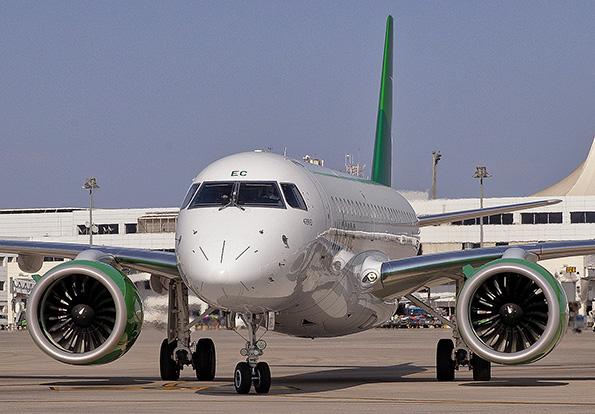
The state of the European market in midsummer 2020 is summed up in one statistic. On June 10, Norwegian regional airline Widerøe operated 250 flights, making it the second-busiest European passenger airline that day.
A research note from Jefferies Equity Research described the Widerøe statistic as “yet another remarkable data point thrown up by COVID-19.” Jefferies warned that European traffic will probably only recover once business travelers return. “To date, airlines that have restarted operations have seen little business demand,” it pointed out.
European traffic hit a low of 2,099 flights on April 12. To put that in perspective, UK LCC easyJet alone operated an average of 1,660 flights per day in 2019. But the market is beginning to reawaken and Eurocontrol expected 9,000 daily flights during the second half of June, rising to 10,500 a day in early July.
If European countries take a coordinated approach to the lifting of quarantines and border closures, Eurocontrol estimates that 32% of flights could operate by July, building to 50% in August and 80% by year-end. Unfortunately, not everyone is taking a coordinated approach.
“Countries that allow flights, but with quarantines, see almost no increase in travel,” IATA chief economist Brian Pearce said.
The UK government was forced to rework its 14-day quarantine rule for almost all incoming travelers in favor of travel corridor agreements with approved countries, after being widely criticized and prompting legal challenges from British Airways parent International Airlines Group (IAG), easyJet and Irish LCC Ryanair.
European Union (EU) borders did begin to reopen from July 1, as the bloc lifted restrictions on nonessential travel from a number of countries, but the US was not included on the list because of its continuing rise in COVID cases. This will undoubtedly hinder the recovery of the transatlantic market, extending the revenue crisis for US and EU carriers, but likely hurting the latter more because of their greater dependence on the transatlantic market.
Early victims
Some European airlines became early pandemic victims. UK regional Flybe, which was in the “at risk” category before the virus struck, entered administration on March 5 after 40 years of flying. Others that were felled include Air Italy, German Airways, IAG’s LEVEL Europe and SunExpress Germany. Swedish domestic carrier Braathens Regional Airlines and Irish regional CityJet both applied for court-approved restructuring—roughly the equivalent of administration—and Ryanair is turning its Vienna-based LCC Laudamotion into a wet-lease provider.
Even before the pandemic, Europe had seen a string of airline failures, including Slovenia’s Adria Airways, French carrier Aigle Azur, Italy’s Ernest Airlines, leisure group Thomas Cook and France’s XL Airways. However, other airlines, like Alitalia and LCC Norwegian, seem to survive against all odds.
Alitalia plans to operate over 1,000 weekly flights in July, increasing its network to 52 routes, despite entering administration over three years ago. After a long search for buyers, an Alitalia relaunch plan led by Italian rail operator Ferrovie dello Stato (FS), with partners Delta Air Lines and infrastructure group Atlantia, failed to materialize. Italy responded with plans for a €3 billion ($3.4 billion) renationalization, but this could be rejected under EU state aid rules because Alitalia was in trouble before the crisis.
Norwegian CEO Jacob Schram said the company had been “on the path” to a positive net profit in 2020 before COVID-19 hit. Norwegian responded with a worst-case scenario plan to “hibernate” until April 2021 before gradually relaunching short- and long-haul operations for the 2021 high season and returning to normal in 2022. However, Norwegian has since completed a vital NOK12.7 billion ($1.3 billion) debt-to-equity conversion, giving it the equity ratio needed to unlock a NOK3 billion loan guarantee and paving the way for its “New Norwegian” strategy. The LCC plans to restore 76 routes from July and double its fleet from eight active Boeing 737-800s to 20.
Restructuring
Lufthansa has also faced strong headwinds and was forced into a battle with its largest shareholder before it could finalize a €9 billion state-backed bailout and avoid filing for bankruptcy. The funding was ultimately agreed, but Lufthansa may have to surrender up to 24 slots at Frankfurt and Munich to new competitors. The group plans to operate 380 aircraft, roughly half of its fleet, by the end of October. Lufthansa CEO Carsten Spohr said the company will undergo a “fundamental restructuring.” With the German government now owning a share in the company and having board representation, Lufthansa could be a very different company from what it was before COVID.
Air France-KLM is also restructuring after securing €7 billion in funding for Air France and a further €3.4 billion for KLM. Both government-backed initiatives have sustainability strings attached, in line with calls from environmental lobby groups during the crisis.
IAG seems to have fared better than its rivals despite practically no assistance from the UK government for aviation. “Other large legacy airlines are unable to survive on their own, but IAG entered the crisis with much higher levels of liquidity (€10 billion),” Daniel Roeska from Bernstein Research observed in late May. “With more liquidity, it should exit the crisis in a better position than other legacies and have the ability to capitalize on strategic upside, rather than focusing solely on repairing wounds inflicted by the crisis.”
Ryanair CEO Michael O’Leary plans to launch legal challenges against several airlines that have received rescue aid. “This and other bailouts will have a more devastating long-term effect on the future of European aviation than the pandemic itself,” O’Leary said.
Central and Eastern European carrier Wizz Air has bullishly emerged from the crisis, announcing several new bases and accelerating its plans to create Wizz Air Abu Dhabi.
“Many carriers don’t have any money to invest into anything, but we are benefiting from this situation because we have the financial strength to expand,” Wizz Air CEO József Váradi said.
While Wizz and Ryanair maintained flights as long as possible through the crisis, easyJet took a different approach, voluntarily grounding its fleet to conserve cash from March 30.
EasyJet now plans to operate around 30% of its normal capacity by the end of September, resuming 50% of its 1,022 routes in July and building to 75% in August, albeit at lower frequencies. EasyJet announced a £450 million ($560 million) share placement and deferred 32 Airbus A320 family aircraft that were originally scheduled to arrive before December 2021.
Overall, the European high season has turned into a river of red ink. Virtually every airline is restructuring, cutting jobs and chasing funds.
“The European market is a mess, and the public health versus economic activity tug-of-war means it’s likely going to get worse before it gets better,” Patrick Edmond, head of aviation consultancy Altair Advisory, said.
“We’ll see a cautious patchwork resumption of flights over the coming weeks, likely followed by an increase in infections a few weeks later and perhaps a new round of restrictions. It’s desperately hard for airlines to plan, and many European airlines who are neither cash-rich enough not to care nor big enough to have their national finance minister’s mobile number, aren’t going to make it through.”

